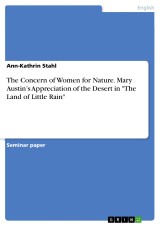Details

The Concern of Women for Nature. Mary Austin's Appreciation of the Desert in "The Land of Little Rain"
1. Auflage
|
13,99 € |
|
| Verlag: | Grin Verlag |
| Format: | |
| Veröffentl.: | 29.11.2016 |
| ISBN/EAN: | 9783668352810 |
| Sprache: | englisch |
| Anzahl Seiten: | 13 |
Dieses eBook erhalten Sie ohne Kopierschutz.
Beschreibungen
Seminar paper from the year 2014 in the subject American Studies - Literature, grade: 1,0, Johannes Gutenberg University Mainz, language: English, abstract: “In response to the industrial revolution of the late 18th century” (Scheese 6) a new field of literary studies has been established. Derived from former pastoralism, authors now engage into what is called ‘nature writing’. Addressing the concerns of life in the country, attention is directed to the different forms of nature as well. One of these nature writers can be found in Mary Hunter Austin, an American writer who expresses her “affinity for nature, and more particularly the desert” (Scheese 76) by describing the landscape of the Mojave Desert in Southern California the way she perceived it during her walks through it.
Austin successfully creates a whole new picture of it in her work "The Land of Little Rain". Through her celebration of a land often perceived as sterile and uninteresting, Austin helped create in America what had not existed before the turn of the century: a desert aesthetic.
What Scheese here calls “a desert aesthetic” (Scheese 75) describes the establishment of a literary discourse exclusively centered around literature about the desert. Desert literature itself offers numerous possibilities for writers at the beginning of the twentieth century, especially for female writers as it “inspired cultural fantasies and enabled real and imagined experiences of solitude, comntemplative repose, divine revelation” (Gersdorf 16). As a consequence, the stories of female writers can be understood as symbolic since the action is moved from a former domestic space to the public sphere in form of the desert. This also conforms to the character of the concept of ‘New Womanhood’ which signifies a newly gained freedom for women at the end of the nineteenth century as their determination of staying within the domestic sphere was finally abandoned.
To prove this statement, the following essay initially gives a short overview of the literary study of nature writing and its more recent descendant, namely ‘desert literature’. Moreover, the second part of the essay will show how Mary Hunter Austin succeeds in transferring her appreciation of the desert into
her short story collection "The Land of Little Rain", where she attributes utopian qualities to the theme of the desert. The third part will finally analyze Austin’s novel with regard to her gender, her concern for nature and the developments concerning the ecofeminist movement at the beginning of the
twentieth century.
Austin successfully creates a whole new picture of it in her work "The Land of Little Rain". Through her celebration of a land often perceived as sterile and uninteresting, Austin helped create in America what had not existed before the turn of the century: a desert aesthetic.
What Scheese here calls “a desert aesthetic” (Scheese 75) describes the establishment of a literary discourse exclusively centered around literature about the desert. Desert literature itself offers numerous possibilities for writers at the beginning of the twentieth century, especially for female writers as it “inspired cultural fantasies and enabled real and imagined experiences of solitude, comntemplative repose, divine revelation” (Gersdorf 16). As a consequence, the stories of female writers can be understood as symbolic since the action is moved from a former domestic space to the public sphere in form of the desert. This also conforms to the character of the concept of ‘New Womanhood’ which signifies a newly gained freedom for women at the end of the nineteenth century as their determination of staying within the domestic sphere was finally abandoned.
To prove this statement, the following essay initially gives a short overview of the literary study of nature writing and its more recent descendant, namely ‘desert literature’. Moreover, the second part of the essay will show how Mary Hunter Austin succeeds in transferring her appreciation of the desert into
her short story collection "The Land of Little Rain", where she attributes utopian qualities to the theme of the desert. The third part will finally analyze Austin’s novel with regard to her gender, her concern for nature and the developments concerning the ecofeminist movement at the beginning of the
twentieth century.

















